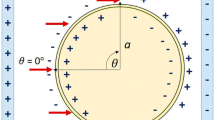Abstract
Formation of a water bridge across the lipid bilayer is the first stage of pore formation in molecular dynamic (MD) simulations of electroporation, suggesting that the intrusion of individual water molecules into the membrane interior is the initiation event in a sequence that leads to the formation of a conductive membrane pore. To delineate more clearly the role of water in membrane permeabilization, we conducted extensive MD simulations of water bridge formation, stabilization, and collapse in palmitoyloleoylphosphatidylcholine bilayers and in water–vacuum–water systems, in which two groups of water molecules are separated by a 2.8 nm vacuum gap, a simple analog of a phospholipid bilayer. Certain features, such as the exponential decrease in water bridge initiation time with increased external electric field, are similar in both systems. Other features, such as the relationship between water bridge lifetime and the diameter of the water bridge, are quite different between the two systems. Data such as these contribute to a better and more quantitative understanding of the relative roles of water and lipid in membrane electropore creation and annihilation, facilitating a mechanism-driven development of electroporation protocols. These methods can be extended to more complex, heterogeneous systems that include membrane proteins and intracellular and extracellular membrane attachments, leading to more accurate models of living cells in electric fields.








Similar content being viewed by others
References
Berendsen HJC, Postma JPM, van Gunsteren WF (1981) Interaction models for water in relation to protein hydration. In: Pullman B (ed) Intermolecular forces. Reidel, Dordrecht, pp 331–342
Berendsen HJC, Postma JPM, van Gunsteren WF et al (1984) Molecular dynamics with coupling to an external bath. J Chem Phys 81:3684–3690
Berger O, Edholm O, Jahnig F (1997) Molecular dynamics simulations of a fluid bilayer of dipalmitoylphosphatidylcholine at full hydration, constant pressure, and constant temperature. Biophys J 72:2002–2013
Böckmann RA, de Groot BL, Kakorin S et al (2008) Kinetics, statistics, and energetics of lipid membrane electroporation studied by molecular dynamics simulations. Biophys J 95:1837–1850
Bussi G, Donadio D, Parrinello M (2007) Canonical sampling through velocity rescaling. J Chem Phys 126:014101
DeBruin KA, Krassowska W (1999) Modeling electroporation in a single cell. I. Effects of field strength and rest potential. Biophys J 77:1213–1224
Essmann U, Perera L, Berkowitz MD et al (1995) A smooth particle mesh Ewald method. J Chem Phys 103:8577–8593
Fernández ML, Marshall G, Sagués F et al (2010) Structural and kinetic molecular dynamics study of electroporation in cholesterol-containing bilayers. J Phys Chem B 114:6855–6865
Fernández ML, Risk M, Reigada R et al (2012) Size-controlled nanopores in lipid membranes with stabilizing electric fields. Biochem Biophys Res Commun 423:325–330
Heller LC, Heller R (2006) In vivo electroporation for gene therapy. Hum Gene Ther 17:890–897
Hess B, Bekker H, Berendsen HJC et al (1997) LINCS: a linear constraint solver for molecular simulations. J Comput Chem 18:1463–1472
Hess B, Kutzner C, van der Spoel D et al (2008) GROMACS 4: algorithms for highly efficient, load-balanced, and scalable molecular simulation. J Chem Theory Comput 4:435–447
Humphrey W, Dalke A, Schulten K (1996) VMD: visual molecular dynamics. J Mol Graph 14:33–38
Koronkiewicz S, Kalinowski S, Bryl K (2002) Programmable chronopotentiometry as a tool for the study of electroporation and resealing of pores in bilayer lipid membranes. Biochim Biophys Acta 1561:222–229
Krassowska W, Filev PD (2007) Modeling electroporation in a single cell. Biophys J 92:404–417
Levine ZA, Vernier PT (2010) Life cycle of an electropore: field-dependent and field-independent steps in pore creation and annihilation. J Membr Biol 236:27–36
Levine ZA, Vernier PT (2012) Calcium and phosphatidylserine inhibit lipid electropore formation and reduce pore lifetime. J Membr Biol 245:599–610
Mir LM, Morsli N, Garbay JR et al (2003) Electrochemotherapy: a new treatment of solid tumors. J Exp Clin Cancer Res 22(4 Suppl):145–148
Miyamoto S, Kollman PA (1992) SETTLE: an analytical version of the SHAKE and RATTLE algorithm for rigid water models. J Comput Chem 13:952–962
Neu JC, Krassowska W (1999) Asymptotic model of electroporation. Phy Rev E 59:3471–3482
Neumann E, Schaefer-Ridder M, Wang Y et al (1982) Gene transfer into mouse lyoma cells by electroporation in high electric fields. EMBO J 1:841–845
Okuno Y, Minagawa M, Matsumoto H et al (2009) Simulation study on the influence of an electric field on water evaporation. J Mol Struct (Theochem) 904:83–90
Piggot TJ, Holdbrook DA, Khalid S (2011) Electroporation of the E. coli and S. aureus membranes: molecular dynamics simulations of complex bacterial membranes. J Phys Chem B 115:13381–13388
Tarek M (2005) Membrane electroporation: a molecular dynamics simulation. Biophys J 88:4045–4053
Teissie J, Golzio M, Rols MP (2005) Mechanisms of cell membrane electropermeabilization: a minireview of our present (lack of?) knowledge. Biochim Biophys Acta 1724:270–280
Tieleman DP (2004) The molecular basis of electroporation. BMC Biochem 5:10
Vernier PT, Ziegler MJ (2007) Nanosecond field alignment of head group and water dipoles in electroporating phospholipid bilayers. J Phys Chem B 111:12993–12996
Vernier PT, Levine ZA, Gundersen MA (2013) Water bridges in electropermeabilized phospholipid bilayers. Proc IEEE 101:494–504
Weaver JC, Chizmadzhev YA (1996) Theory of electroporation: a review. Bioelectrochem Bioenerg 41:135–160
Ziegler MJ, Vernier PT (2008) Interface water dynamics and porating electric fields for phospholipid bilayers. J Phys Chem B 112:13588–13596
Zimmermann U, Pilwat G, Riemann F (1974) Dielectric breakdown of cell membranes. Biophys J 14:881–899
Author information
Authors and Affiliations
Corresponding author
Rights and permissions
About this article
Cite this article
Ho, MC., Levine, Z.A. & Vernier, P.T. Nanoscale, Electric Field-Driven Water Bridges in Vacuum Gaps and Lipid Bilayers. J Membrane Biol 246, 793–801 (2013). https://doi.org/10.1007/s00232-013-9549-4
Received:
Accepted:
Published:
Issue Date:
DOI: https://doi.org/10.1007/s00232-013-9549-4




